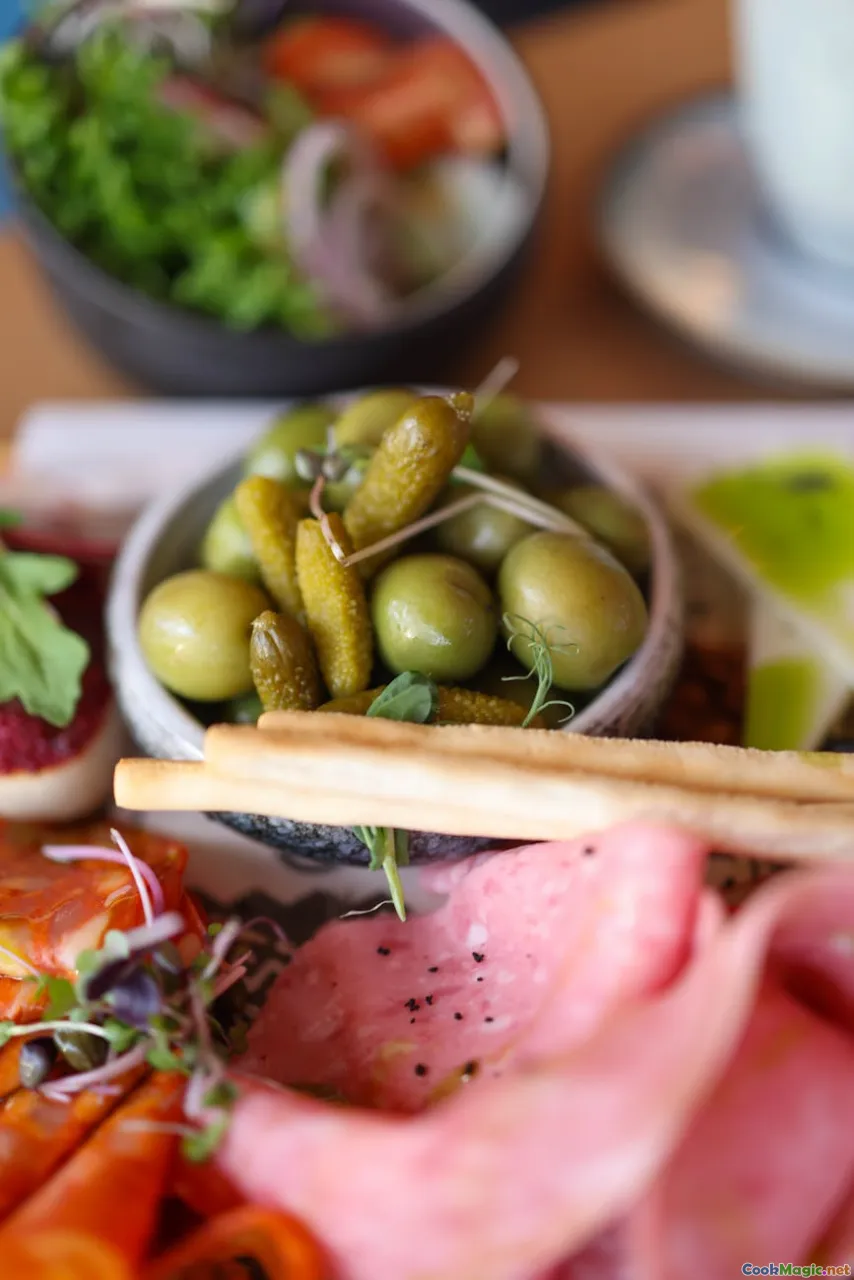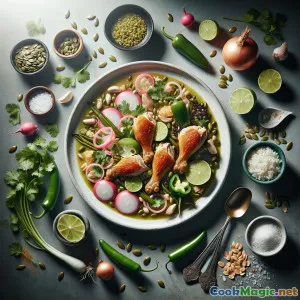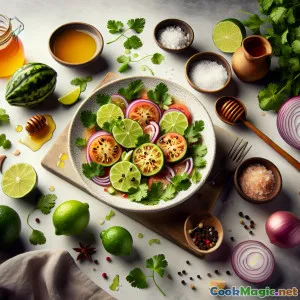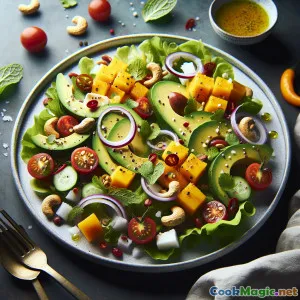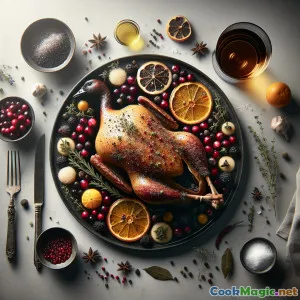
Giăm Bông Đầy Màu Sắc của Guatemala cho Ngày Thánh
(Colorful Guatemalan Fiambre for All Saints Day)
(0 Đánh giá)0
973
tháng 7 14, 2025
Báo cáo sự cố
Nguyên liệu
-
200 grams Củ dền nấu chín thái lát
(Củ cải đỏ hoặc vàng, luộc chín và làm lạnh)
-
150 grams Cà rốt luộc
(Cắt lát)
-
120 grams Đậu xanh
(Cắt tỉa và trụng sơ)
-
120 grams Cánh súp lơ
(Chần sơ đến mức giòn)
-
250 grams Thịt ức gà
(luộc, để nguội và xé nhỏ)
-
200 grams Giăm bông
(Cắt thành sợi mỏng)
-
100 grams Salami
(cắt lát mỏng)
-
80 grams xúc xích chorizo
(Cắt thành từng lát)
-
100 grams Phô mai ngâm (queso fresco)
(Cắt thành khối)
-
50 grams Ngô non muối chua
-
60 grams Hành tím ngâm giấm
-
80 grams Dưa chuột muối chua
(Cắt lát)
-
80 grams Ô liu xanh
(Không hạt)
-
80 grams Ô liu đen
(Không hạt)
-
4 large Trứng
(Trứng luộc chín và cắt tư)
-
1 bunch Ngò rí
(Ngon tay tươi bằm nhỏ để trang trí)
-
1 head Lá xà lách
(Rửa sạch và còn nguyên)
-
200 ml Nước sốt dầu giấm
(Hỗn hợp dầu ô liu, giấm, một chút mù tạt Guatemala, tiêu đen và oregano)
-
2 tbsp Những quả caper
(Rửa sạch và để ráo)
-
3 medium Củ cải
(Cắt mỏng để trang trí)
(Củ cải đỏ hoặc vàng, luộc chín và làm lạnh)
(Cắt lát)
(Cắt tỉa và trụng sơ)
(Chần sơ đến mức giòn)
(luộc, để nguội và xé nhỏ)
(Cắt thành sợi mỏng)
(cắt lát mỏng)
(Cắt thành từng lát)
(Cắt thành khối)
(Cắt lát)
(Không hạt)
(Không hạt)
(Trứng luộc chín và cắt tư)
(Ngon tay tươi bằm nhỏ để trang trí)
(Rửa sạch và còn nguyên)
(Hỗn hợp dầu ô liu, giấm, một chút mù tạt Guatemala, tiêu đen và oregano)
(Rửa sạch và để ráo)
(Cắt mỏng để trang trí)
Dinh dưỡng
- Khẩu phần: 10
- Kích thước khẩu phần: 1 đĩa lớn thịnh soạn (350g)
- Calories: 360 kcal
- Carbohydrates: 19 g
- Protein: 22 g
- Fat: 19 g
- Fiber: 5 g
- Sugar: 6 g
- Sodium: 885 mg
- Cholesterol: 206 mg
- Calcium: 160 mg
- Iron: 2.7 mg
Hướng dẫn
-
1 - Chuẩn bị rau củ và thịt:
Lột vỏ và luộc củ cải đường, cà rốt, đậu que và súp lơ. Làm nguội hoàn toàn. Nấu chín và cắt nhỏ ức gà, giăm bông và chorizo nếu cần. Chuẩn bị tất cả các loại thịt và phô mai bằng cách thái mỏng hoặc cắt khối để xếp lớp.
-
2 - Sắp xếp nhóm thành phần:
Trên một đĩa lớn hoặc nhiều đĩa, xếp các lá xà lách làm lớp nền. Sắp xếp các thành phần thành từng chùm gọn gàng, chồng lên nhau—ví dụ như củ dền, hỗn hợp dưa chua, thịt đã sơ chế, rồi đến các loại phô mai—để tạo thành các sọc sặc sỡ.
-
3 - Thêm Trứng và Rau Củ Trang Trí:
Cắt trứng lòng đào làm tư và xếp lên trên salad. Thêm lát củ cải, hành ngâm chua, ngô và rắc ô liu cùng capers để tạo sự đa dạng về màu sắc và hương vị.
-
4 - Rưới sốt Vinaigrette:
Trộn đều dầu ô liu, giấm, mù tạt, tiêu và oregano. Rưới nhẹ tất cả lên salad, đảm bảo mỗi nhóm rau củ, pho mát và thịt đều được phủ đều. Để hương vị hòa quyện trong tủ lạnh, đậy kín và để ít nhất 1 giờ.
-
5 - Trang trí và phục vụ:
Ngay trước khi phục vụ, rắc lên chút ngọn rau mùi tươi xắt nhỏ. Dọn trực tiếp từ đĩa lớn, đảm bảo mỗi đĩa đều có một phần cắt ngang thể hiện rõ các hương vị và kết cấu.
Lột vỏ và luộc củ cải đường, cà rốt, đậu que và súp lơ. Làm nguội hoàn toàn. Nấu chín và cắt nhỏ ức gà, giăm bông và chorizo nếu cần. Chuẩn bị tất cả các loại thịt và phô mai bằng cách thái mỏng hoặc cắt khối để xếp lớp.
Trên một đĩa lớn hoặc nhiều đĩa, xếp các lá xà lách làm lớp nền. Sắp xếp các thành phần thành từng chùm gọn gàng, chồng lên nhau—ví dụ như củ dền, hỗn hợp dưa chua, thịt đã sơ chế, rồi đến các loại phô mai—để tạo thành các sọc sặc sỡ.
Cắt trứng lòng đào làm tư và xếp lên trên salad. Thêm lát củ cải, hành ngâm chua, ngô và rắc ô liu cùng capers để tạo sự đa dạng về màu sắc và hương vị.
Trộn đều dầu ô liu, giấm, mù tạt, tiêu và oregano. Rưới nhẹ tất cả lên salad, đảm bảo mỗi nhóm rau củ, pho mát và thịt đều được phủ đều. Để hương vị hòa quyện trong tủ lạnh, đậy kín và để ít nhất 1 giờ.
Ngay trước khi phục vụ, rắc lên chút ngọn rau mùi tươi xắt nhỏ. Dọn trực tiếp từ đĩa lớn, đảm bảo mỗi đĩa đều có một phần cắt ngang thể hiện rõ các hương vị và kết cấu.
Thông tin thêm về: Giăm Bông Đầy Màu Sắc của Guatemala cho Ngày Thánh
The Story and Spirit Behind Guatemalan Fiambre Tradicional del 1 de Noviembre
If you've ever visited Guatemala during October’s end, you may encounter the dizzying scent of pickles, the tapestry-like color flashes of beets, peppers, green beans and eggs, all arranged magisterially onto platters that seem ablaze with edible confetti. This is Fiambre Tradicional del 1 de Noviembre—perhaps Guatemala’s most iconic cold salad and an appetizer, main dish, and centerpiece of memory-making all in one. It is joy, remembrance, unity, and family—flavors threaded across generations and afterlives.
Historical and Cultural Significance
Fiambre isn’t merely food. It’s a living quilt. This recipe has its roots deeply planted in colonial times with precedent in Spanish and Moorish antipasto. Over centuries, swept up through generations of Catholic influence and indigenous rituals honoring the dead, it emerged as Guatemala's commemorative Table of the Dead feast for Día de Todos los Santos (All Saints' Day, November 1st). Each family tweaks its own Fiambre recipe—an edible act of homage. Ingredients are selected not just for taste, but for their symbolic ties to deceased relatives: some meats for toughness (strength), eggs for life, and so on. Preparing Fiambre is a matter for consultation amongst ancestors—no two salads are ever truly the same from house to house or year to year.
Fiambre’s Unique Aspects
What sets Fiambre apart from anything you’ve tasted? It’s the sheer variety and balance. Cold, reserved vegetables (beets, cauliflower, carrots, beans, corn), prepared ahead and chilled, are an aromatic rainbow among finely sliced chorizo, salami, chicken, ham, and cheese. These are united with marinated vegetables like baby corn, capers, and myriad olives listed by the handful. Its vinaigrette, suffused with vinegar, smooth olive oil, Guatemalan mustard, oregano, sometimes even a trace of that family’s secret spice, soaks into the entire dish, marrying tang with the cooling mouthfeel and textural surprises.
After marinating, chilled for at least an hour, the dish is presented whole—a wild geometric layering of ingredients. Guests are served so each plate receives meat, veg, cheese, and garnish, welcoming all assembled and remembered. Some regions add seafood (fiambre rojo), while vegetarian takes exist (fiambre verde). Feel free to substitute local charcuterie or vegetarian sausages.
Preparing Fiambre at Home
Making fiambre is a task best done ahead—and even better as a collective event with family. Slice, cube, and allocate your components so that on an expansive platter, there’s visual order and balance: the slide of shining red beetroots laid against slices of pink ham, crisp florets of white cauliflower beside chartreuse gherkins, bright yellow pickled corn standing upright. Hard boiled eggs intersperse for softness, cheeses alternate for boldness. Set it all off with green herbs and savory vinaigrette.
It’s customary and practical to marinate the completed platter for an hour or more, giving flavors time to develop. Some even assemble it on October 31st, providing plenty of time for every meat and pickle to express its personality.
Serving and Personal Reflection
As a chef, few things are more gratifying than serving fiambre. The gasps from first-timers who marvel at the color story, followed by their beaming faces after the first bite—a taste surprising silky, bold, tart, sweet, deeply savory—illustrate its magic. Fiambre morphs the very idea of salad from a side act to main event; every version is a fingerprint for a family.
Beyond flavor, preparing fiambre brings people together: each person engaged at the table offers more than another set of hands—they put forward decades of memory and affection for those absent and present. It deepens one's respect for ancestors and celebrates identity—culinary, familial, and national. If you want to host a tradition that's intensely personal yet simultaneously inclusive, carve out a night this autumn for Fiambre.
Tips & Notes
- Advance preparation and refrigeration are key. Flavors improve overnight.
- Use a blend of fresh and pickled vegetables for authentic texture play.
- Don’t over-saturate with vinaigrette—drizzle lightly and allow guests to add their own.
- Arrange leftovers in jars—fiambre keeps well for days and develops increasingly complex flavors.
Honor, flavor, vivid memories, and the colors of life: that’s what awaits you in every bite of Fiambre Tradicional del 1 de Noviembre.

